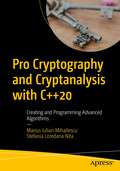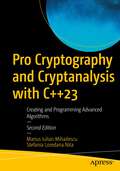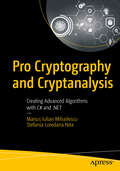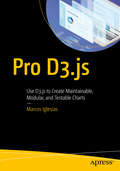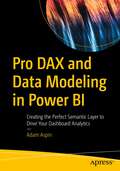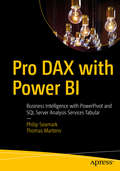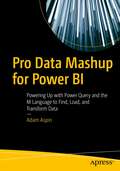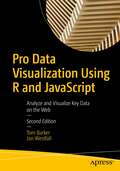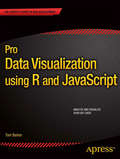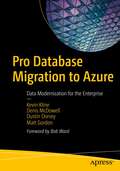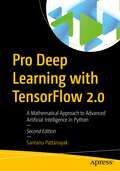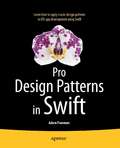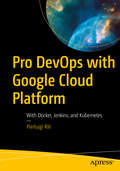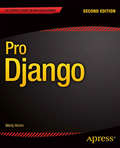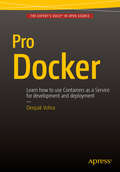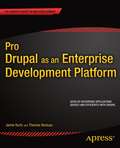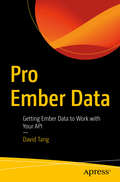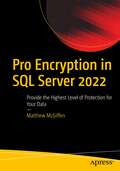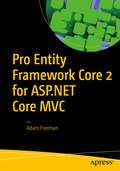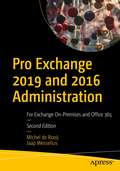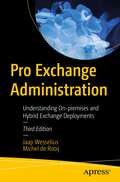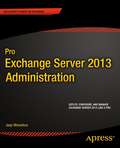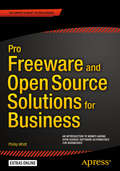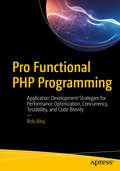- Table View
- List View
Pro Cryptography and Cryptanalysis with C++20: Creating and Programming Advanced Algorithms
by Stefania Loredana Nita Marius Iulian MihailescuDevelop strong skills and a passion for writing cryptography algorithms and security schemes/modules using C++ 20 and its new features. You will find the right methods of writing advanced cryptographic algorithms (such as, elliptic curve cryptography algorithms, lattice-based cryptography, searchable encryption, and homomorphic encryption), examine internal cryptographic mechanisms, and discover common ways in which the algorithms could be implemented and used correctly in practice. The authors avoid the complexities of the mathematical background by explaining its mathematical basis in terms that a programmer can easily understand. They show how “bad” cryptography creeps in during implementation and what “good” cryptography should look like. They do so by showing and comparing the advantages and disadvantages based on processing time, execution time, and reliability. What You Will Learn Understand where and why cryptography is used and how it gets misused Discover what modern cryptography algorithms and methods are used for Design and implement advanced cryptographic mechanisms See how C++20 and its new features are impacting the future of implementing cryptographic algorithms Practice the basics of public key cryptography, including ECDSA signatures and more Find out how most of the algorithms can be broken Who This Book Is For Professional programmers, developers, and software engineers who are developing cryptography algorithms and security schemes/modules in C++. Prior C++ programming and IDE experience and some basic experience of cryptography concepts (symmetric and asymmetric) highly recommended.
Pro Cryptography and Cryptanalysis with C++23: Creating and Programming Advanced Algorithms
by Stefania Loredana Nita Marius Iulian MihailescuDevelop strong skills for writing cryptographic algorithms and security schemes/modules using C++23 and its new features. This book will teach you the right methods for writing advanced cryptographic algorithms, such as elliptic curve cryptography algorithms, lattice-based cryptography, searchable encryption, and homomorphic encryption. You'll also examine internal cryptographic mechanisms and discover common ways in which the algorithms can be implemented and used correctly in practice. The authors explain the mathematical basis of cryptographic algorithms in terms that a programmer can easily understand. They also show how “bad” cryptography can creep in during implementation and what “good” cryptography should look like by comparing advantages and disadvantages based on processing time, execution time, and reliability. What You Will Learn Discover what modern cryptographic algorithms and methods are used for Design and implement advanced cryptographic mechanisms See how C++23 and its new features are impact the implementation of cryptographic algorithms Practice the basics of public key cryptography, including ECDSA signatures and more See how most of the algorithms can be broken Who This Book Is For Professional programmers, developers, and software engineers who are developing cryptography algorithms and security schemes/modules in C++. Prior C++ programming and IDE experience and some basic experience of cryptography concepts (symmetric and asymmetric) highly recommended.
Pro Cryptography and Cryptanalysis: Creating Advanced Algorithms with C# and .NET
by Stefania Loredana Nita Marius Iulian MihailescuUtilize this comprehensive, yet practical, overview of modern cryptography and cryptanalysis to improve performance. Learn by example with source code in C# and .NET, and come away with an understanding of public key encryption systems and challenging cryptography mechanisms such as lattice-based cryptography.Modern cryptography is the lifeboat of a secure infrastructure. From global economies and governments, to meeting everyday consumer needs, cryptography is ubiquitous, and used in search, design, data, artificial intelligence, and other fields of information technology and communications. Its complexity can lead to misconfiguration, misuse, and misconceptions. For developers who are involved in designing and implementing cryptographic operations in their applications, understanding the implications of the algorithms, modes, and other parameters is vital. Pro Cryptography and Cryptanalysis is for the reader who has a professional need or personal interest in developing cryptography algorithms and security schemes using C# and .NET. You will learn how to implement advanced cryptographic algorithms (such as Elliptic Curve Cryptography Algorithms, Lattice-based Cryptography, Searchable Encryption, Homomorphic Encryption), and come away with a solid understanding of the internal cryptographic mechanisms, and common ways in which the algorithms are correctly implemented in real practice. With the new era of quantum computing, this book serves as a stepping stone to quantum cryptography, finding useful connections between current cryptographic concepts and quantum related topics. What You Will Learn Know when to enlist cryptography, and how it is often misunderstood and misusedExplore modern cryptography algorithms, practices, and propertiesDesign and implement usable, advanced cryptographic methods and mechanismsUnderstand how new features in C# and .NET impact the future of cryptographic algorithmsUse the cryptographic model, services, and System.Security.Cryptography namespace in .NETModernize your cryptanalyst mindset by exploiting the performance of C# and .NET with its weak cryptographic algorithmsPractice the basics of public key cryptography, including ECDSA signaturesDiscover how most algorithms can be broken Who This Book Is ForInformation security experts, cryptologists, software engineers, developers, data scientists, and academia who have experience with C#, .NET, as well as IDEs such as Visual Studio, VS Code, or Mono. Because this book is for an intermediate to advanced audience, readers should also possess an understanding of cryptography (symmetric and asymmetric) concepts.
Pro D3.js: Use D3.js to Create Maintainable, Modular, and Testable Charts
by Marcos IglesiasGo beyond the basics of D3.js to create maintainable, modular, and testable charts and to package them into a library that can be distributed as open source software or kept for private use. This book will show you how to transform regular D3.js chart code into reusable and extendable modules.You know the basics of working with D3.js, but it's time to become a professional D3.js practitioner. This book is your launching pad to refactoring code, composing complex visualizations from small components, working as a team with other developers, and integrating charts with a Continuous Integration system. You'll begin by creating a production-ready chart using D3.js v5, ES2015, and a test-driven approach and then move on to using and extending Britecharts, the reusable charting library based on Reusable API patterns. Finally, you'll see how to use D3.js along with React to document and build your charts to compose a charting library you can release into the NPM repository. With Pro D3.js, you'll become an accomplished D3.js developer in no time. What You Will Learn Create v5 D3.js charts with ES2016 and unit testsDevelop modular, testable and extensible code with the Reusable API patternWork with and extend Britecharts, a reusable charting library created at EventbriteUse Webpack and npm to create and publish a charting library from your own chart collectionsWrite reference documentation and build a documentation homepage for your library. Who This Book Is For Data scientists, data visualization engineers, and frontend developers with a fundamental knowledge of D3.js and some experience with JavaScript, as well as data journalists and consultants.
Pro DAX and Data Modeling in Power BI: Creating the Perfect Semantic Layer to Drive Your Dashboard Analytics
by Adam AspinDevelop powerful data models that bind data from disparate sources into a coherent whole. Then extend your data models using DAX–the query language that underpins Power BI–to create reusable measures to deliver finely-crafted custom calculations in your dashboards.This book starts off teaching you how to define and enhance the core structures of your data model to make it a true semantic layer that transforms complex data into familiar business terms. You’ll learn how to create calculated columns to solve basic analytical challenges. Then you’ll move up to mastering DAX measures to finely slice and dice your data.The book also shows how to handle temporal analysis in Power BI using a Date dimension. You will see how DAX Time Intelligence functions can simplify your analysis of data over time. Finally, the book shows how to extend DAX to filter and calculate datasets and develop DAX table functions and variables to handle complex queries.What You Will LearnCreate clear and efficient data models that support in-depth analyticsDefine core attributes such as data types and standardized formatting consistently throughout a data modelDefine cross-filtering settings to enhance the data modelMake use of DAX to create calculated columns and custom tablesExtend your data model with custom calculations and reusable measures using DAXPerform time-based analysis using a Date dimension and Time Intelligence functionsWho This Book Is ForEveryone from the CEO to the Business Intelligence developer and from BI and Data architects and analysts to power users and IT managers can use this book to outshine the competition and create the data framework that they need and interactive dashboards using Power BI
Pro DAX with Power BI: Business Intelligence with PowerPivot and SQL Server Analysis Services Tabular
by Philip Seamark Thomas MartensLearn the intricate workings of DAX and the mechanics that are necessary to solve advanced Power BI challenges. This book is all about DAX (Data Analysis Expressions), the formula language used in Power BI—Microsoft’s leading self-service business intelligence application—and covers other products such as PowerPivot and SQL Server Analysis Services Tabular. You will learn how to leverage the advanced applications of DAX to solve complex tasks.Often a task seems complex due to a lack of understanding, or a misunderstanding of core principles, and how certain components interact with each other. The authors of this book use solutions and examples to teach you how to solve complex problems. They explain the intricate workings of important concepts such as Filter Context and Context Transition. You will learn how Power BI, through combining DAX building blocks (such as measures, table filtering, and data lineage), can yield extraordinary analytical power. Throughout Pro Dax with Power BI these building blocks are used to create and compose solutions for advanced DAX problems, so you can independently build solutions to your own complex problems, and gain valuable insight from your data.What You Will Learn Understand the intricate workings of DAX to solve advanced problemsDeconstruct problems into manageable parts in order to create your own recipesApply predefined solutions for addressing problems, and link back step-by-step to the mechanics of DAX, to know the foundation of this powerful query languageGet fully on board with DAX, a new and evolving language, by learning best practices Who This Book Is ForAnyone who wants to use Power BI to build advanced and complex models. Some experience writing DAX is helpful, but not essential if you have experience with other data query languages such as MDX or SQL.
Pro Data Mashup for Power BI: Powering Up with Power Query and the M Language to Find, Load, and Transform Data
by Adam AspinThis book provides all you need to find data from external sources and load and transform that data into Power BI where you can mine it for business insights and a competitive edge. This ranges from connecting to corporate databases such as Azure SQL and SQL Server to file-based data sources, and cloud- and web-based data sources. The book also explains the use of Direct Query and Live Connect to establish instant connections to databases and data warehouses and avoid loading data. The book provides detailed guidance on techniques for transforming inbound data into normalized data sets that are easy to query and analyze. This covers data cleansing, data modification, and standardization as well as merging source data into robust data structures that can feed into your data model. You will learn how to pivot and transpose data and extrapolate missing values as well as harness external programs such as R and Python into a Power Query data flow. You also will see how to handle errors in source data and extend basic data ingestion to create robust and parameterized data load and transformation processes. Everything in this book is aimed at helping you deliver compelling and interactive insight with remarkable ease using Power BI’s built-in data load and transformation tools.What You Will LearnConnect Power BI to a range of external data sourcesPrepare data from external sources for easy analysis in Power BI Cleanse data from duplicates, outliers, and other bad valuesMake live connections from which to refresh data quickly and easilyApply advanced techniques to interpolate missing dataWho This Book Is ForAll Power BI users from beginners to super users. Any user of the world’s leading dashboarding tool can leverage the techniques explained in this book to turbo-charge their data preparation skills and learn how a wide range of external data sources can be harnessed and loaded into Power BI to drive their analytics. No previous knowledge of working with data, databases, or external data sources is required—merely the need to find, transform, and load data into Power BI..
Pro Data Visualization Using R and JavaScript: Analyze and Visualize Key Data on the Web
by Tom Barker Jon WestfallUse R 4, RStudio, Tidyverse, and Shiny to interrogate and analyze your data, and then use the D3 JavaScript library to format and display that data in an elegant, informative, and interactive way. You will learn how to gather data effectively, and also how to understand the philosophy and implementation of each type of chart, so as to be able to represent the results visually. With the popularity of the R language, the art and practice of creating data visualizations is no longer the preserve of mathematicians, statisticians, or cartographers. As technology leaders, we can gather metrics around what we do and use data visualizations to communicate that information. Pro Data Visualization Using R and JavaScript combines the power of the R language with the simplicity and familiarity of JavaScript to display clear and informative data visualizations. Gathering and analyzing empirical data is the key to truly understanding anything. We can track operational metrics to quantify the health of our products in production. We can track quality metrics of our projects, and even use our data to identify bad code. Visualizing this data allows anyone to read our analysis and easily get a deep understanding of the story the data tells. This book makes the R language approachable, and promotes the idea of data gathering and analysis mostly using web interfaces. What You Will Learn Carry out data visualization using R and JavaScript Use RStudio for data visualization Harness Tidyverse data pipelines Apply D3 and R Notebooks towards your data Work with the R Plumber API generator, Shiny, and more Who This Book Is For Programmers and data scientists/analysts who have some prior experience with R and JavaScript.
Pro Data Visualization using R and JavaScript
by Tom BarkerPro Data Visualization using R and JavaScript makes the R language approachable, and promotes the idea of data gathering and analysis. You'll see how to use R to interrogate and analyze your data, and then use the D3 JavaScript library to format and display that data in an elegant, informative, and interactive way. You will learn how to gather data effectively, and also how to understand the philosophy and implementation of each type of chart, so as to be able to represent the results visually. With the popularity of the R language, the art and practice of creating data visualizations is no longer the preserve of mathematicians, statisticians, or cartographers. As technology leaders, we can gather metrics around what we do and use data visualizations to communicate that information. Pro Data Visualization using R and JavaScript combines the power of the R language with the simplicity and familiarity of JavaScript to display clear and informative data visualizations. Gathering and analyzing empirical data is the key to truly understanding anything. We can track operational metrics to quantify the health of our products in production. We can track quality metrics of our projects, and even use our data to identify bad code. Visualizing this data allows anyone to read our analysis and easily get a deep understanding of the story the data tells.
Pro Database Migration to Azure: Data Modernization for the Enterprise
by Kevin Kline Matt Gordon Denis McDowell Dustin DorseyMigrate your existing, on-premises applications into the Microsoft Azure cloud platform. This book covers the best practices to plan, implement, and operationalize the migration of a database application from your organization’s data center to Microsoft’s Azure cloud platform.Data modernization and migration is a technologically complex endeavor that can also be taxing from a leadership and operational standpoint. This book covers not only the technology, but also the most important aspects of organization culture, communication, and politics that so frequently derail such projects. You will learn the most important steps to ensuring a successful migration and see battle-tested wisdom from industry veterans. From executive sponsorship, to executing the migration, to the important steps following migration, you will learn how to effectively conduct future migrations and ensure that your team and your database application delivers on the expected business value of the project. This book is unlike any other currently in the market. It takes you through the most critical business and technical considerations and workflows for moving your data and databases into the cloud, with special attention paid to those who are deploying to the Microsoft Data Platform in Azure, especially SQL Server. Although this book focuses on migrating on-premises SQL Server enterprises to hybrid or fully cloud-based Azure SQL Database and Azure SQL Managed Instances, it also cover topics involving migrating non-SQL Server database platforms such as Oracle, MySQL, and PostgreSQL applications to Microsoft Azure.What You Will LearnPlan a database migration that ensures smooth project progress, optimal performance, low operating cost, and minimal downtimeProperly analyze and manage non-technical considerations, such as legal compliance, privacy, and team executionPerform a thorough architectural analysis to select the best Azure services, performance tiers, and cost-containment featuresAvoid pitfalls and common reasons for failure relating to corporate culture, intra-office politics, and poor communicationsSecure the proper executive champions who can execute the business planning needed for successApply proven criteria to determine your future-state architecture and your migration methodExecute your migration using a process proven by the authors over years of successful projectsWho This Book Is ForIT leadership, strategic IT decision makers, project owners and managers, and enterprise and application architects. For anyone looking toward cloud migration projects as the next stage of growth in their careers. Also useful for enterprise DBAs and consultants who might be involved in such projects. Readers should have experience and be competent in designing, coding, implementing, and supporting database applications in an on-premises environment.
Pro Deep Learning with TensorFlow 2.0: A Mathematical Approach to Advanced Artificial Intelligence in Python
by Santanu PattanayakThis book builds upon the foundations established in its first edition, with updated chapters and the latest code implementations to bring it up to date with Tensorflow 2.0. Pro Deep Learning with TensorFlow 2.0 begins with the mathematical and core technical foundations of deep learning. Next, you will learn about convolutional neural networks, including new convolutional methods such as dilated convolution, depth-wise separable convolution, and their implementation. You’ll then gain an understanding of natural language processing in advanced network architectures such as transformers and various attention mechanisms relevant to natural language processing and neural networks in general. As you progress through the book, you’ll explore unsupervised learning frameworks that reflect the current state of deep learning methods, such as autoencoders and variational autoencoders. The final chapter covers the advanced topic of generative adversarial networks and their variants, such as cycle consistency GANs and graph neural network techniques such as graph attention networks and GraphSAGE. Upon completing this book, you will understand the mathematical foundations and concepts of deep learning, and be able to use the prototypes demonstrated to build new deep learning applications. What You Will Learn Understand full-stack deep learning using TensorFlow 2.0Gain an understanding of the mathematical foundations of deep learning Deploy complex deep learning solutions in production using TensorFlow 2.0Understand generative adversarial networks, graph attention networks, and GraphSAGE Who This Book Is For: Data scientists and machine learning professionals, software developers, graduate students, and open source enthusiasts.
Pro Design Patterns in Swift
by Adam FreemanThe Swift programming language has transformed the world of iOS development and started a new age of modern Cocoa development. Pro Design Patterns in Swift shows you how to harness the power and flexibility of Swift to apply the most important and enduring design patterns to your applications, taking your development projects to master level. This book will teach you those design patterns that have always been present at some level in your code, but may not have been recognized, acknowledged, or fully utilized. Implementation of specific pattern approaches will prove their value to any Swift developer. Best-selling author Adam Freeman explains how to get the most from design patterns. He starts with the nuts-and-bolts and shows you everything through to advanced features, going in-depth to give you the knowledge you need. Pro Design Patterns in Swift brings design patterns to life and shows you how to bring structure and scale to your Swift code with a practical, no-nonsense approach. In this book, you'll learn: Gain a solid, practical understanding of why and when design patterns are useful Master classic patterns like singleton, abstract factory, chain of responsibility, and observerDiscover less well-known patterns like memento, composite, command, and mediatorUnderstand how Swift provides essential language features for writing well-structured code that is easy to understand, simple to test and readily maintainable. Learn how to consume the Cocoa API to implement classic design patternsBuild on your existing programming knowledge to get up and running with design patterns in Swift quickly and effectively
Pro DevOps with Google Cloud Platform: With Docker, Jenkins, And Kubernetes
by Pierluigi RitiUse DevOps principles with Google Cloud Platform (GCP) to develop applications and services. This book builds chapter by chapter to a complete real-life scenario, explaining how to build, monitor, and maintain a complete application using DevOps in practice.Starting with core DevOps concepts, continuous integration, and continuous delivery, you’ll cover common tools including Jenkins, Docker, and Kubernetes in the context of a real microservices application to deploy in the cloud. You will also create a monitor for your cloud and see how to use its data to prevent errors and improve the stability of the system. By the end of Pro DevOps with Google Cloud Platform, you will be able to deploy, maintain, and monitor a real application with GCP.What You Will LearnBuild and deploy applications and services using DevOps on Google Cloud Platform Maintain a complete continuous integration (CI) and continuous delivery (CD) pipelineUse containerization with Docker and KubernetesCarry out CD with GCP and JenkinsCreate microservices with Jenkins, Docker, and KubernetesMonitor your newly deployed application and its deployment and performanceSet up security and manage your network with GCP Who This Book Is ForDevelopers and software architects who want to implement DevOps in practice. Some prior programming experience is recommended as well as a basic knowledge of a Linux command-line environment.
Pro Django
by Marty AlchinDjango is the leading Python web application development framework. Learn how to leverage the Django web framework to its full potential in this advanced tutorial and reference. Updated for Django 1.6 and Python 3, Pro Django, Second Edition examines in great detail the sometimes complex problems that Python web application developers can face and how to solve them. Provides in-depth information about advanced tools and techniques available in every Django installation Runs the gamut from the theory of Django's internal operations to actual code that solves real-world problems for high-volume environments Goes above and beyond other books, leaving the basics behind Shows how Django can do things even its core developers never dreamed possible
Pro Docker
by Deepak VohraIn this fast-paced book on the Docker open standards platform for developing, packaging and running portable distributed applications, author Deepak Vohra discusses how to build, ship and run applications on any platform such as a PC, the cloud, data center or a virtual machine. He describes how to install Docker images and create Docker containers, and the advantages of Docker containers. The remainder of the book is devoted to discussing using Docker with important software solutions. He begins by discussing using Docker with a traditional RDBMS using Oracle and MySQL. Next he moves on to NoSQL with chapter on MongoDB Cassandra, and Couchbase. Then he addresses the use of Docker in the Hadoop ecosystem with complete chapters on utilizing not only Hadoop, but Hive, HBase, Sqoop, Kafka, Solr and Spark. What you'll learn How to install a Docker image How to create a Docker container How to run an Application in a Docker Container Use Docker with Apache Hadoop Ecosystem Use Docker with NoSQL Databases Use Docker with RDBMS Who this book is for Apache Hadoop Developers. Database developers. NoSQL Developers. Table of Contents Section I Getting Started 1. Hello Docker 2. Installing Linux Section II Relational Databases 3. Oracle Database 4. MySQL Database Section III NoSQL Databases 5. MongoDB 6. Apache Cassandra 7. Couchbase Section IV Apache Hadoop Ecosystem 8. Apache Hadoop 9. Apache Hive 10. Apache HBase 11. Apache Sqoop 12. Apache Kafka 13. Apache Solr 14. Apache Spark
Pro Drupal as an Enterprise Development Platform
by Jamie Kurtz Thomas BesluauIn Pro Drupal as an Enterprise Development Platform authors Jamie Kurtz and Thomas Besluau explain how developers can save themselves time and money, and build their applications faster with fewer bugs by using the Drupal CMS as a foundation for their projects. The days when custom client applications were built entirely from scratch are over. Today, it makes business sense to use a flexible, highly scalable framework such as Drupal, Joomla or DotNetNuke as a foundation. This book focuses on why Drupal makes a particularly strong choice for the majority of developers. With an unprecedented level of community support, tens of thousands of well-proven plug-ins and modules available for download, and advanced content management rules and configuration engines Drupal is flexible enough to provide a firm base upon which almost all enterprise application developers can build their own custom solutions. As this book will make clear, it is no longer necessary for developers to write complex applications entirely from scratch for each of their clients. Instead,they should begin by using an enterprise-class CMS like Drupal to provide a robust foundation for them so that they can concentrate their time and skills into solving the business-specific problems of each individual client maximizing the value that they add to each assignment. What you'll learn Understand how Drupal supports enterprise-grade application development. Follow a comprehensive walk-through of the common business continuity, regulatory and security concerns that come with using Drupal. See how to integrate Drupal into new or existing service-oriented architectures (SOA). Be inspired by the many and varied application build types that Drupal supports. Get a head-start on your competition! Who this book is for This book is targeted at enterprise software developers, architects, and managers looking to increase productivity and reduce time to market on new services, applications, features, and bug fixes. Knowledge of PHP is not required. Table of Contents A New Era of Software Development The Drupal Content Management System Business Application Fundamentals Implementing Application Behaviors Securing Your Application Working with Content System Configuration User Experience Design REST Services with Drupal Software Development Best Practices with Drupal How to Sell and Implement Drupal in Your Enterprise
Pro Ember Data: Getting Ember Data to Work with Your API
by David TangLearn how to work with Ember Data efficiently, from APIs, adapters, and serializers to polymorphic relationships, using your existing JavaScript and Ember knowledge. This book will teach you how to adapt Ember Data to fit your custom API.Have a custom API that you aren't sure how to use with Ember Data? Interested in writing your own adapter or serializer? Want to just know more about how Ember Data works? This is the Ember Data book you have been waiting for. Lots of books and tutorials start off teaching Ember with Ember Data. This is great, especially if you are in control of your API, but what if you aren't? You do a little research and start seeing terminology like adapters, serializers, transforms, and snapshots, and quickly become overwhelmed. Maybe you've thought to yourself that Ember isn't for you. Well, if this sounds familiar, then this book is for you. What You'll Learn Review the differences between normalization and serializationUnderstand how the built-in adapters and serializers in Ember Data workCustomize adapters and serializers to consume any API and write them from scratchHandle API errors in Ember DataWork with the Reddit API using Ember DataLearn how to use polymorphic relationships Who This Book Is For Anyone with an interest in learning more about Ember Data and how to adapt it to any API. People who read this book should be familiar with the basics of Ember and JavaScript.
Pro Encryption in SQL Server 2022: Provide the Highest Level of Protection for Your Data
by Matthew McGiffenThis in-depth look at the encryption tools available in SQL Server shows you how to protect data by encrypting it at rest with Transparent Data Encryption (TDE) and in transit with Transport Level Security (TLS). You will know how to add the highest levels of protection for sensitive data using Always Encrypted to encrypt data also in memory and be protected even from users with the highest levels of access to the database. The book demonstrates actions you can take today to start protecting your data without changing any code in your applications, and the steps you can subsequently take to modify your applications to support implementing a gold standard in data protection. The book highlights work that Microsoft has been doing since 2016 to make encryption more accessible, by making TDE available in the standard edition, and the introduction of Always Encrypted that requires minimal work on your part to implement powerful and effective encryption, protecting your data and meeting regulatory requirements. The book teaches you how to work with the encryption technologies in SQL Server with the express goal of helping you understand those technologies on an intuitive level. You’ll come away with a deep level of understanding that allows you to answer questions and speak as an expert. The book’s aim is to make you as comfortable in deploying encryption in SQL Server as you would be in driving your car to buy groceries. Those with a data security mindset will appreciate the discussion of how each feature protects you and what it protects you from, as well as how to implement things in the most secure manner. Database administrators will appreciate the high level of detail around managing encryption over time and the effect of encryption on database performance. All readers will appreciate the advice on how to avoid common pitfalls, ensuring that your projects to implement encryption run smoothly.What You Will LearnArchitect an effective encryption strategy for new applicationsRetrofit encryption into your existing applicationsEncrypt data at rest, in memory, and in transitManage key and certificate life cycles, including backup and restoreRecover encrypted databases in case of server failureWork with encryption in cloud-based scenariosWho This Book Is ForDatabase developers, architects, and administrators who want to work with encryption in SQL Server; those who want to maintain encryption whether data is at rest or being transmitted over the network; and those who wish to encrypt their data even when in the server’s own memory. Readers should be familiar with SQL Server, but no existing knowledge of encryption is assumed.
Pro Entity Framework Core 2 for ASP.NET Core MVC
by Adam FreemanModel, map, and access data effectively with Entity Framework Core 2, the latest evolution of Microsoft’s object-relational mapping framework. You will access data utilizing .NET objects via the most common data access layer used in ASP.NET Core MVC 2 projects. Best-selling author Adam Freeman explains how to get the most from Entity Framework Core 2 in MVC projects. He begins by describing the different ways that Entity Framework Core 2 can model data and the different types of databases that can be used. He then shows you how to use Entity Framework Core 2 in your own MVC projects, starting from the nuts and bolts and building up to the most advanced and sophisticated features, going in-depth to give you the knowledge you need. Chapters include common problems and how to avoid them.What You’ll LearnGain a solid architectural understanding of Entity Framework Core 2Create databases using your MVC data model Create MVC models using an existing database Access data in an MVC application using Entity Framework Core 2Use Entity Framework in RESTful Web ServicesWho This Book Is ForASP.NET Core MVC 2 developers who want to use Entity Framework Core 2 as the data access layer in their projects
Pro Exchange 2019 and 2016 Administration: For Exchange On-Premises and Office 365
by Jaap Wesselius Michel de RooijUse this one-stop resource for both basic and advanced administration of Exchange Server 2019 and 2016. It will help you in running an Exchange environment, whether it be 100% on-premises or a hybrid configuration with Exchange Online (as part of Office 365).This revised version is divided into four parts, describing Exchange infrastructure, upgrading Exchange server, integration with Office 365, and security and compliance. In the first part, you will go through a short introduction of Exchange server followed by its installation and configuration. You will learn client access along with Exchange mailbox and managing Exchange recipients. In the second part, you will learn how to upgrade from Exchange 2010 to 2016 and from 2013 to Exchange 2019. The third part is dedicated to the Exchange integration with Office 365, followed by the last part that teaches you how to secure your Exchange environment and its compliance.After reading this book, you will understand best practices, do’s and don’ts, and notes from the field to migrate and work on Exchange 2016 and 2019.What You Will LearnCreate a highly available and redundant Exchange environmentUnderstand security, message hygiene (CEO fraud, for example), and complianceKnow the infrastructure changes in Exchange 2019Integrate and manage hybrid recipientsWho This Book Is ForIT pros who are responsible for building and maintaining an Exchange environment, both on-premises and in a hybrid configuration with Exchange Online
Pro Exchange Administration: Understanding On-premises and Hybrid Exchange Deployments
by Jaap Wesselius Michel de RooijMove to the current version of Exchange Server, whether it be stand-alone, on-premises, or in a hybrid configuration with Exchange Online. This updated edition provides background information on Exchange 2019, and teaches you how to bring it up to date and keep it up to date in a consistent state.The book starts with an introduction to Exchange Server, Active Directory, Exchange Online, and Azure Active Directory (AD). It takes you through designing and installing Exchange Server and guides you in managing it. You will learn Microsoft 365 integration with Azure AD in your Exchange Server. Moving to Exchange Online, Mail Flow, and authentication are also discussed, so you will better understand hybrid transport. As you progress through the book, you will see how to secure your Exchange Server with Azure App Proxy, message hygiene, and multi-factor authentication. Also covered are corporate compliance needs such as backup and restore, message records management, auditing, and information rights management. After reading this book, you will not only be able to install, configure, and maintain Exchange Server, you will also know how to secure and monitor the environment. What You Will LearnSecure your Exchange environment, including message hygieneCreate the best hybrid solution available for your needs using the best of both worldsImplement compliancy features in Exchange ServerManage and monitor the Exchange environmentWho This Book Is ForSystem administrators, Windows administrators, network administrators, system engineers
Pro Exchange Server 2013 Administration
by Jaap WesseliusPro Exchange Server 2013 Administration is your best-in-class companion for gaining a deep, thorough understanding of Microsoft's powerful enterprise collaboration and communications server. Author Jaap Wesselius is at your side as you administer every facet of Exchange Server 2013, revealing tips, tricks, and little known facts that will make your administration life simpler and more effective. Along with revealing what's new in Exchange Server 2013, this well-paced, deeply engaging tutorial provides detailed deployment guidance, for upgraders and migrators as well as for organizations entirely new to the Exchange platform. The book details how all of the major Exchange components fit together, from SMTP messages to all kinds of clients. It also provides in-depth configuration examples with an eye toward creating scalable, reliable, and secure installations. Additionally, this guide covers the tools and techniques for monitoring an Exchange environment and troubleshooting when things go wrong. With Pro Exchange Server 2013 Administration, you will: * Learn how to install Exchange Server fresh or upgrade from a previous version * Get a comprehensive understanding of Exchange, with thorough coverage of Mailbox server and Client Access server * Understand the tools and techniques for configuring and managing your Exchange deployment to ensure scalability, reliability, efficiency and security * Learn how to monitor your deployment and prepare for any problems and how to troubleshoot any problems that do arise What you'll learn A comprehensive set of best practices for administering Exchange Server 2013 on a daily basis. A thorough understanding of new features. How to design and deploy new Exchange 2013 servers and upgrade existing Exchange servers to Exchange 2013. Learn best practices for high availability and disaster recovery. Understand the differences and similarities between Exchange on-premise and Exchange Online. Who this book is for Pro Exchange Server 2013 Administration is intended for mail system administrators and architects who design, deploy, and support messaging infrastructures that include Microsoft Exchange. Table of Contents 1. Introduction to Exchange 2013 2. Exchange 2013 Deployments 3. Coexistence and Migration 4. Client Access 5. Mailbox 6. Managing Exchange 2013 7. Backup, Restore and Disaster Recovery 8. Monitoring Exchange 2013 9. Troubleshooting Exchange 2013
Pro Freeware and Open Source Solutions for Business
by Phillip WhittPro Freeware and Open Source Solutions for Business is a practical guide for the small business owner seeking viable alternative to expensive commercial software packages and subscriptions. This reference guide provides an overview of many popular and powerful free alternatives to proprietary software. Not only can small business owners benefit from this book, but educators and students can as well. In this book you will find free and open source solutions for office productivity, PDF creation, accounting, image editing and graphic design, desktop publishing, 3D design, CAD, audio and video editing, website and blog creation, customer relationship management, point of sale, networking and security, and alternatives to the Windows and Macintosh operating systems. This guide helps free the cost-conscious business owner from the bonds of expensive proprietary software by exploring the free and powerful alternatives that exist. You can save a substantial sums of money by replacing just a few commercial software titles with free and open source solutions. Learn how with Pro Freeware and Open Source Solutions for Business today. What you'll learn Learn the difference between freeware and open source applications Why open source software is gaining more traction, especially in cities throughout Europe The potential savings each application offers Which software is ideal for your particular needs Which commercial title each application replaces The potential cost savings each application offers Which operating system(s) each software title runs on Where to get support for a particular software title Who this book is for Pro Freeware and Open Source Solutions for Business is written for the cost-conscious small business owner who needs viable software solutions to run their organization, but without the exorbitant price tags and restrictions that accompany proprietary packages. Small business owners will discover workable replacements for big name packages, such as Microsoft, Adobe, and Quick Books Pro, among others. This book is written for the time-conscious business owner and puts tons of valuable information at the reader's fingertips. All of the heavy research has been done and is presented clearly. Table of Contents Chapter 1: Office Productivity, Note Taking, Accounting, and PDF Creation Chapter 2: Point-of-sale, CRM, Backup, and Compression Software Chapter 3: Desktop Publishing, Illustration, Painting, and 3D Modeling Software Chapter 4: Photo Editing Software Chapter 5: Audio-Video Capture, Conversion and Editing Software Chapter 6: Project Planning, Inventory Management, and Time Tracking Software Chapter 7: Web Site Creation Software and Web Browsers Chapter 8: Content Management Solutions Chapter 9: Network and Security Utilities Chapter 10: Linux: The Free Alternative to Windows and Mac OS Appendix A: Professional Profiles Appendix B: Additional Software Products Appendix C: Resources for Free and Open Source Software
Pro Freeware and Open Source Solutions for Business: Money-Saving Options for Small Enterprises
by Phillip WhittThis book will point the way to numerous free, low-cost, and open-source software solutions that could provide viable alternatives to their paid counterparts. Pro Freeware and Open Source Solutions for Business is now in its Second Edition; it has been thoroughly revised and updated. This book covers the most up-to-date software versions. Software described in the First Edition that is no longer available has been replaced with comparable titles when possible. The book starts with an office productivity tool known as OfficeLibre and goes on to explain CRM and compression software. You will then learn about desktop publishing, illustration, 3D modeling, and photo editing software. As we progress further, you will learn more about audio-video capture and editing software along with Openshot, an easy-to-use free video editor. You will also learn about available project planning and time tracking software, and much more. By the end of the book, you will have also gained knowledge about security programs, as well as how to use Linux on Windows and MacOS. With the challenging economic times we find ourselves in, this book may be more important than ever to help small business owners eliminate and reduce costs, and keep more money in their business. . What You Will Learn Understand the important differences between freeware and open-source software.Discern which paid commercial software the free version replaces (when applicable).Gain insight into how organizations and municipalities around the world adopting open-source software to save money on licensing fees. Who This Book Is For Primarily small business owners, solo entrepreneurs or freelancers on a budget, and cost efficiency experts.
Pro Functional PHP Programming
by Rob AleyBring the power of functional programming to your PHP applications. From performance optimizations to concurrency, improved testability to code brevity, functional programming has a host of benefits when compared to traditional imperative programming. Part one of Pro Functional PHP Programming takes you through the basics of functional programming, outlining the key concepts and how they translate into standard PHP functions and code. Part two takes this theory and shows you the strategies for implementing it to solve real problems in your new or existing PHP applications. Functional programming is popular in languages such as Lisp, Scheme and Clojure, but PHP also contains all you need to write functional code. This book will show you how to take advantage of functional programming in your own projects, utilizing the PHP programming language that you already know. What You'll Learn Discover functional programming in PHP Work with functional programming functions Design strategies for high-performance applications Manage business logic with functions Use functional programming in object-oriented and procedural applications Employ helper libraries in your application Process big data with functional PHP Who This Book Is For Programmers and web developers with experience of PHP who are looking to get more out of their PHP coding and be able to do more with PHP.
